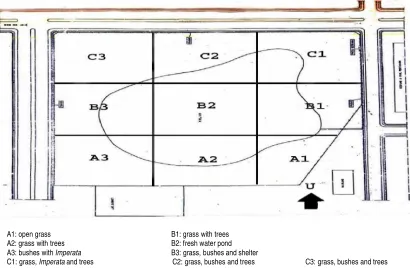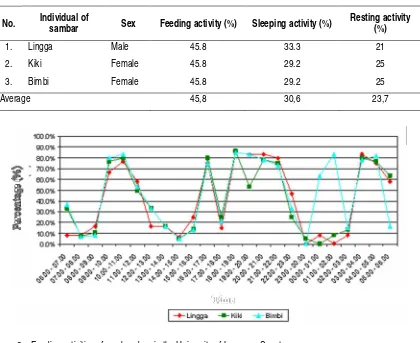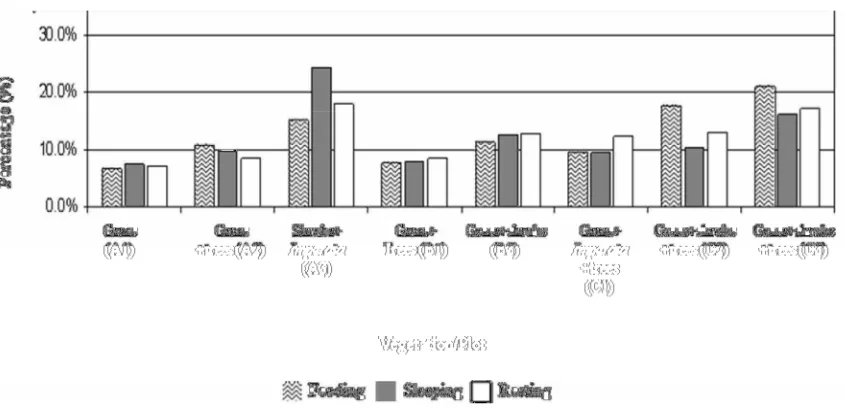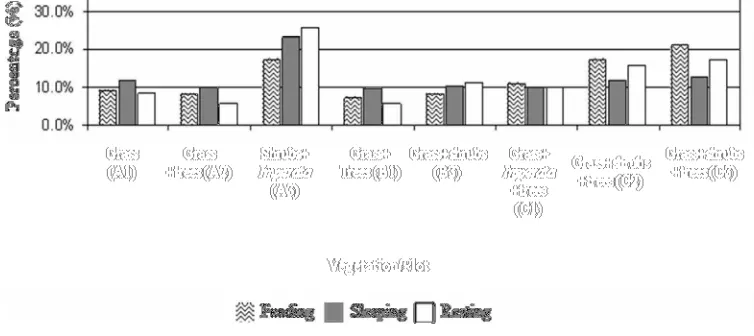35
Daily Activity And Microhabitat Preference of Sambar Deer (Cervus UnicolorKerr, 1792) In The
University of Lampung Sanctuary
(Aktifitas Harian dan Preferensi Mikrohabitat Rusa Sambar (Cervus Unicolor Kerr, 1792) di Penangkaran
Universitas Lampung)
Nefi GUSMASARI1) and Elly L. RUSTIATI2)
1,2)Department of Biology, College of Mathematics and Natural Sciences, University of Lampung,
JL. Soemantri Brojonegoro 1, Bandar Lampung 35145. E-mail:[email protected]
ABSTRAK. Kajian tentang aktifitas harian dan preferensi mikrohabitat terhadap ekor rusa sambar telah dilakukan di Penangkaran Universitas Lampung dengan metodescanning. Kondisi umum areal penangkaran diamati dengan metoderapid assessment. Pencatatan vegetasi penyusun habitat dilakukan dengan pengamatan kuadran setiap satu meter. Aktivitas tertinggi yang dilakukan adalah aktivitas makan (45,8%), diikuti aktivitas tidur (30,6 %) dan istirahat (23,7 %). Preferensi mikrohabitat rusa sambar meliputi area bervegetasi semak alang-alang untuk aktivitas tidur dan istirahat, dan area bervegetasi rumput, semak dan pohon untuk aktivitas makan.
Keywords : sambar deer, Cervus unicolor, daily activity, microhabitat preference, feeding, sleeping and resting activities
ABSTRACT. The study to learn the daily activity and microhabitat preference of sambar deer was conducted in the University of Lampung Sanctuary by scanning method. The general condition of the sanctuary was observed by rapid assessment method, vegetation registration was noted by one meter-quadrant. The highest daily activity proportion were feeding (45.8%), followed by sleeping (30.6%) and resting (23.7%) respectively. Sambar microhabitat preferences includedImperata- bushed areas for sleeping and resting activities and areas with grasses, shrubs and trees for feeding activity.
Kata kunci :rusa sambar,Cervus unicolor, aktivitas harian, mikrohabitat, makan, aktivitas istirahat dan tidur.
INTRODUCTION
An alarming worldwide extinction of animal species is taking place as a result of the activities of the increasing global human population. Despite substantial efforts, there are thousands of species threatened by extinction, including sambar deer,Cervus unicolor Kerr 1792, an Indonesian endangered species, characterized by rapid decline due to illegal hunting and trade, as well as habitat loss and degradation. Sustaining viable populations of wildlife species requires the maintenance of habitat, as well as an understanding of the behavior of individual species (Pukazhenthiet al., 2006).
When species become critically endangered, ex-situ recovery programs are the usual first line of defense. The concept of ex-situ management of small captive populations with a view to re-introducing them into the wild is attracting increasing interest. Responding the conservation needs and looking for the benefits from wildlife resources found on the natural land, the
University of Lampung launched sambar deer sanctuary located within campus in 2004.
Some studies have been done related on sanctuary prospect and its captive animals such as horse, deer, Sumatran tiger (Harnal, 2002; King and Gurnell, 2005; Okello, 2005; Zhou, 2004) but knowledge of sambar deer behavior in captivity, especially its daily activity and microhabitat preference is limited, yet information about this important life stage is critical to developing effective conservation strategies and the successful sanctuary management. This study was conducted to investigate the daily activities and microhabitat preference of captive sambar deer in the University of Lampung Sanctuary.
METHOD
36
minute-interval scanning methods to observe their daily activities and choices on microhabitats. Rapid assessment, modified from habitat assessment by Brower (1990), was applied to categorize the vegetation distribution in the area. To observe the microhabitat preference and daily activity, sanctuary area was divided into nine plots based on vegetation types (open grass; grass with trees; shrubs withImperata; Imperata with trees; grass, shrubs and trees). The grasses in the area consist of Axonopus compressus, Imperata cylindrica, Pennisetum purpureum and Cynodon dactylon. The shrubs include Stachytarpheta cayennensis, Salacca sp, Crotalaria anagyroides. The trees consist Acacia auriculiformis, Terminalia cattapa, Jatropa gossipifolia, Cocos nucifera,Tectonus grandica, andBauhinia purpurea.
Activities recorded include feeding, resting and sleeping activities. Feeding activities include reaching, taking and putting the food into the mouth. Resting activities are
non movement such as grooming, laying down, bathing and sitting.
RESULTS AND DISCUSSION
Daily activities of captive sambar deer
The three sambar deer demonstrated both day and night of the daily activities which agreed with the sambar behavior found in the wild (Suzukiet al., 2006). The daily activity started at 09.00 and ended at 23.00. In between 18.00 to 22.00, they roamed in grass area to shrubs-tree area, and started at 03.00 the movement was done vice versa. At 06.00 they oved toImperata area and slept. At 09.00 they went to area especially with trees for feeding activity and possibly looked for shelter against the sun. In general the daily activity patterns of three sambar deer were similar. The highest activity was feeding (45.8%), followed by sleeping (30.6%) and resting (23.7%) respectively (Table 1).
A1: open grass B1: grass with trees
A2: grass with trees B2: fresh water pond
A3: bushes withImperata B3: grass, bushes and shelter
C1: grass,Imperata and trees C2: grass, bushes and trees C3: grass, bushes and trees
Figure 1. Plot divison on the research area of the University of Lampung Sanctuary (adopted from Proyek Peningkatan Perguruan Tinggi (P2T) University of Lampung by scale 1: 5)
All three sambar often did the activities together, but Lingga, the male sambar did the resting and sleeping activities alone, as Lekagul and McNeely (1988) stated the male sambar is usually solitary. Generally feeding activity was conducted almost the all day long, especially at 09.00 12.00, continued at 16.00, 18.00 22.00 and 03.00 06.00, with the highest at 10.00
11.00, 16.00 17.00, 18.00 19.00 and between 03.00 -04.00 (Figure 2). Overall all three sambar started their feeding activities at 09.00, and the highest activities recorded at 18.00.
22.00 and 03.00 (Figure 3). Meanwhile resting activities were done frequently in between feeding activities with
the most carried out at 15.00 - 16.00 and 02.00 - 03.00 (Figure 4).
Table 1. Daily activities of sambar deer
No. Individual of
sambar Sex Feeding activity (%) Sleeping activity (%)
Resting activity (%)
1. Lingga Male 45.8 33.3 21
2. Kiki Female 45.8 29.2 25
3. Bimbi Female 45.8 29.2 25
Average 45,8 30,6 23,7
38
Figure 3. Sleeping activities of sambar deer in the University of Lampung Sanctuary
Figure 4. Resting activities of sambar deer in the University of Lampung Sanctuary
Figure 5. The microhabitat use of sambar deer in the University of Lampung sanctuary
Sleeping activities was observed at 07.00, 12.00 - 15.00 and 23.00 - 02.00 and they tended to do it in the Imperata areas during the day and in the bushes, grass with trees areas during the night. Resting activities were observed at 05.00, 15.00, especially for bathing in the pond, and 17.00.
Microhabitat Preferences
Generally all the areas were used by three sambar deer, and areas with grass, shrubs and trees were for feeding
activity (21.0%) (Figure 5). It is possible due to the variety of its plant species. Sambar in the sanctuary fed randomly on all vegetation in the area. This is agreed with Semiadi dan Nugraha (2004) as stated the sambar fed in almost all the green vegetation in its area and well adapted with the food change.
trees for feeding activity (20.9%), shrubs withImperata for sleeping (29.2%) and resting (25.7%). The least area used was grass and few trees. The other two sambar showed the similar tendency on microhabitat use. Bimbi occupied areas with grass, shrubs and trees for feeding activity (21.0%), bushes and Imperata for
sleeping (24.7%) and resting (20.0%). The least areas used were open grass. Lingga took areas with grass, shrubs and trees also for feeding activity (20.9%), shrubs and Imperata for sleeping (25.0%) and resting (24.0%). (Figure 6, 7, and 8).
Figure 6. The use of microhabitat by sambar Kiki in The University of Lampung sanctuary
40
Figure 8. The use of microhabitat by sambar Lingga in The University of Lampung sanctuary The least areas used were shrubs with Imperata.
Overall, areas which were lack of cover were ignored. It may be lack of shelter and small variety of food plants. This behavior was similar to sambar in the wild which has preference for cover provided by trees or shrubs (Green, 1987). Based on their behavior patterns and microhabitat use that is related to their natural behavior, it is important for maintaining the local diversity in University of Lampung sanctuary, and managing the location suitable for establishment of a wildlife sanctuary.
CONCLUTION
It is concluded that the highest activity of captive sambar deer in the University of Lampung Sanctuary is feeding (45.8%), followed by sleeping (30.6%) and resting (23.7%) respectively. The microhabitat preference of captive sambar deer in the University of Lampung sanctuary is areas with grass, bushes and trees for feeding activity and areas with shrubs andImperata for sleeping and resting.
ACKNOWLEDGEMENT
We would like to thank the University of Lampung Sanctuary for the collaboration and access to conduct the research and collecting the data.
REFERENCES
Asher, G.W.; S.L. Monfort, C. 1999. Comparative reproductive function in cervids: implications for management of farm and zoo populations. Journal of Reproduction and Fertility 54: 143-156
Brower, J.E., H.Z. Jerrold, and C.N.V. Ende. 1990. Field and Laboratory Methods for General Ecology. 3th Edition. Wm. C. Brown Publishers.
United States of America.
Green, M.J.B. 1987. Ecological separation in Himalayan ungulates. Journal of Zoology 1 (4): 693-720
Harnal VK,D.E. Wildt, D.M. Bird, S.L. Monfort, andn J.D. Ballou. 2002. Computer simulations to determine the efficacy of different genome resource banking strategies for maintaining genetic diversity. Cryobiology 44 (2): 122-131 APR 2002
King SRB, and J. Gurnell. 2005. Habitat use and spatial dynamics of takhi introduced to Hustai National Park, Mongolia. Biological Conservation 124 (2): 277-290
Okello, M.M. 2005. An assessment of the large mammal component of the proposed wildlife sanctuary site in Maasai Kuku Group Ranch near Amboseli, Kenya South African. Journal of Wildlife Research 35(1): 63-76.
Pukazhenthi, B.,P. Comizzoli, A.J. Travis, andD.E. Wildt. 2006. Applications of emerging technologies to the study and conservation of threatened and endangered species. Reproduction Fertility and Development 18 (1-2): 77-90.
Semiadi, G dan R. T. P. Nugraha. 2004. Panduan Pemeliharaan Rusa Tropis. Pusat Penelitian Biologi. LIPI. Bogor.
Suzuki, S., S. Kitamura, M. Kon, P. Poonswad, Pilai, P. Chuailua, K. Plongmai, T. Yumoto, N. Noma, T. Maruhashi, andP. Wohandee. 2006. Foraging activity patterns of frugivorous or omnivorous animals on the forest floor of a tropical seasonal forest in Thailand, with reference to seasonal changes. Natural History Bulletin of the Siam Society54 (2): 177-194



